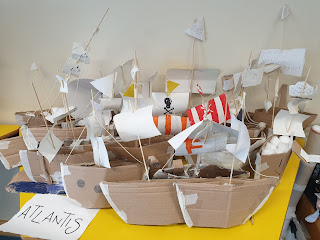Building our banners 1 - 19th June, 2019

Our two main large banners will be made up of approximately 30 printed pieces for each class and using a tessellated brick design will symbolize our journey in building our knowledge of the history of our local textile heritage. Using our notes and drawings from looking through our sketchbooks and our blog last week, we started to think about what we could include on our individual piece which was our decision. It needs to be bold, bright and striking as it will be seen from a distance We will use a combination of techniques to achieve this. We started by adding blocks of colour - some made by printing and others by painting. A really good print using impressed polystyrene tile We masked off areas then used fabric paint to paint blocks of bright colour. Some engraved textile inspired drawings into foam and printed onto the fabric. Over the next few weeks we shall be adding more detail. We aim to have two or three ...



